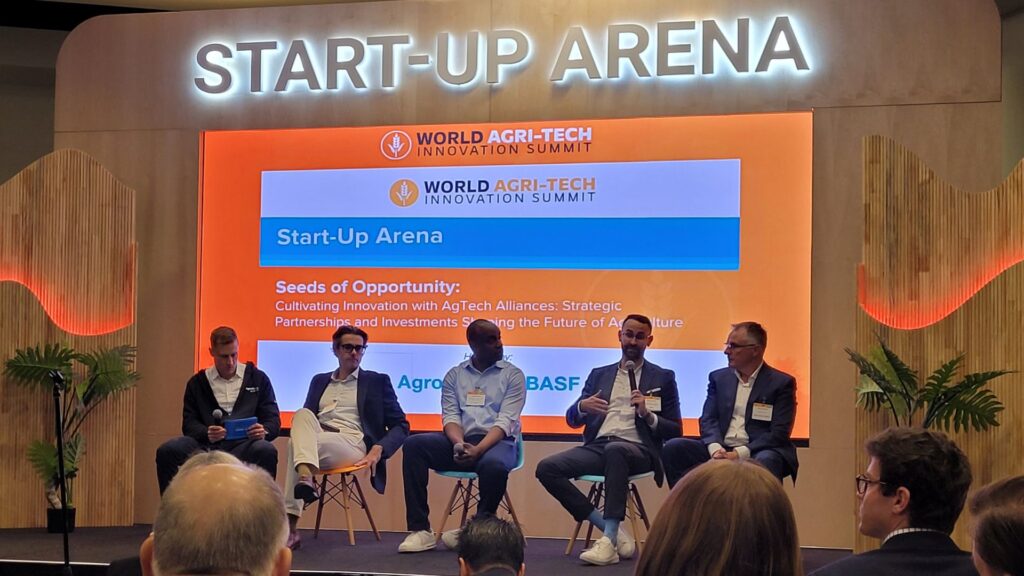The World Agri-Tech Forum in San Francisco in March brought together over 2,000 global leaders and stakeholders. They represented the agri-food industry and gathered to discuss the future of agriculture. The summit focused on “Scaling Performance-Driven Solutions for Climate & Economy” and several key themes emerged:
Key Highlights:
- Increased Collaboration and Consolidation: A significant trend was the growing number of partnerships and collaborations across the value chain. Competing companies are increasingly partnering on new technologies, alongside ongoing acquisitions. Much of this is driven by the uncertain market and regulatory environment. Some key academic and industry stakeholders such as Benjamin Z. Houlton of Cornell University highlighted that cracking this collaborative challenge will be essential to future AgTech success. He said; “Abe Lincoln’s Land Grant Act of 1862 and the food system that came from it was globally innovative. But the US is now behind other regions of the world in R&D and innovation in Ag. Cornell CALS is seeking collaborative ways to change this”
- Focus on the Farmer: There was a strong emphasis on developing solutions that directly benefit farmers and address their profitability. Discussions revolved around not only increasing production but also maximising the profitability of farming practices. “88% of US farm families rely on off-farm income. That’s not a sustainable system. So, as well as productivity innovations, we need innovative solutions to this. Payments for Ecosystem services should be part of it.” Tom Vilsack, former United States Secretary of Agriculture set the tone of the Summit on the opening morning. “Instead of the farmer needing two or three jobs, we need the farm to pay two or three wages”
- Applying Artificial Intelligence: The integration of AI across agriculture was a major highlight. Companies are recognising the need to adopt AI to advance their businesses. AI solutions are becoming more creative and are expected to fundamentally change farming and product development. Land O’Lakes’ Leah Anderson highlighted our opportunities to leverage AI. “AI won’t replace anyone’s job. But the people/ companies who effectively use AI will replace the people who don’t.” It’s still challenging to recognise where AI is most beneficial in terms of application in the field and at farm-level. Sean Wohltman of Google gave a fascinating demo of how Gemini Deep Mind can be used as a low cost R&D facility. He used the example of asking Gemini to report on how a Potato Processor could decide where and with whom to initiate a Regen Ag programme – i.e. where would give best chances of success and ROI. Sean also demo’d Google’s new AI weather model, Weather Next (Global 30km grid). It significantly outperformed traditional empirical weather models when forecasting Hurricane Beryl last summer.
- Food System Resilience and Sustainability: Discussions heavily focused on building more resilient food systems and adopting sustainable farming practices to address climate risks and optimise resource use. Shobha Shetty of The World Bank called out the role of the MRV solution to this: “Unless you have accurate, verified data you can’t make effective decisions and take action. But in-field measurement is slow and costly, so we need reliable, low-cost MRV systems.
- Supply Chain Decarbonisation: They discussed strategies and technologies aimed at reducing greenhouse gas emissions at length. The focus was also on improving the social impact of agricultural supply chains. Carrie Vollmer-Sanders, MBA hosted a thought provoking discussion on the future of ecosystem services payments. Patrick Smith’s Loftus Ranches engaged in the Heineken Regen programme. While his farm had the option to sell soil carbon offsets on the VCM, they opted not to as Patrick says; “If we sell the carbon credits, we also sell the right to tell that story, so we decided not to do that. Whoever buys those credits gets to say they are doing great things for the climate, but we don’t. That’s something that needs to change, as well as standardising carbon measurement to maintain the integrity of regenerative agriculture”.

For me, the conference highlight was a truly insightful roundtable hosted by Kevin Burkam, CEO of the US Farmers and Ranchers in Action. Kevin had recently come from the Commodity Conference in Utah with 10,000 row crop farmers. Despite the fact that US Ag is in a significant recession with Corn and Soybean prices both below the cost of production for the last year, Kevin said there was still an air of optimism among the farmers and ranchers. A significant majority of farmers had supported Trump in the election. While tariffs hurt US Ag under Trump’s first administration, one factor potentially driving the optimism was, that like under Trump 1.0, the new Agriculture Secretary, Millar, is reportedly committing to providing direct payment subsidy safety net to farmers, should the corn and soy recession continue.
USFRA prepared a report for COP 29 which said it was technically possible for US Ag to become Net Zero or even emissions negative. See the full report here: https://cast-science.org/publication/potential-for-u-s-agriculture-to-be-greenhouse-gas-negative/
Kevin asked the roundtable what technologies could help achieve this Net Zero target and there were two responses that received majority support, a) low cost NUE (nitrogen use efficiency) tools and b) low cost slurry management technologies. Methane reduction technology (despite being trialled in vaccine and feed-additive form by large dairies) was seen to be too expensive. It also did not offer the farmer a direct benefit like technologies A and B would.
Kevin summarised the US approach to emissions reductions in Ag as “Efficiency focussed” whereas he sees the EU’s approach as “reductionist focussed” which the roundtable summarised as; “at best, short-sighted” in the context of ensuring food security. Others at the table described a perception of two extremes with “no regulation” in much of the US and “over regulation” in Europe, leading to unintended negative consequences.
Overall, the World Agri-Tech Forum in San Francisco showcased a dynamic and evolving AgriTech landscape. There was a clear emphasis on food system resilience, efficiency, and farmer-centric solutions driven by technological advancements and increased collaboration.
